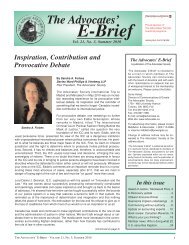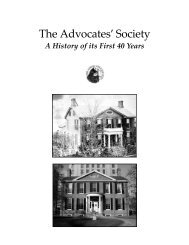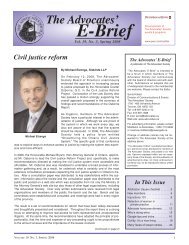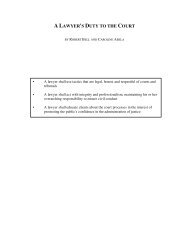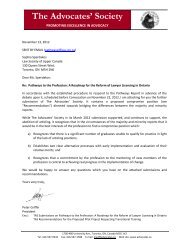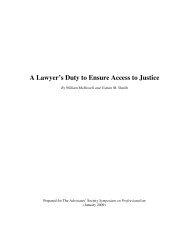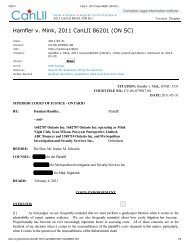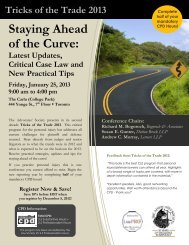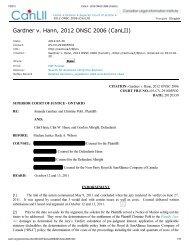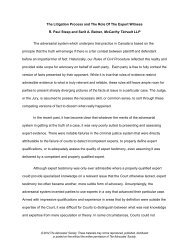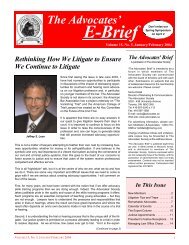E-Brief Sept - Oct - The Advocates' Society
E-Brief Sept - Oct - The Advocates' Society
E-Brief Sept - Oct - The Advocates' Society
- No tags were found...
You also want an ePaper? Increase the reach of your titles
YUMPU automatically turns print PDFs into web optimized ePapers that Google loves.
<strong>The</strong> Advocates’E-<strong>Brief</strong>Vol. 18, No. 1, Summer 2006ol. 18, No. 1, Summer 2006Proud sponsor of<strong>The</strong> Advocates’ <strong>Society</strong>events & programs.www.pwc.com/ca/daiBill 14 Access to Justice Act:<strong>The</strong> <strong>Advocates'</strong> <strong>Society</strong> SubmissionMichael E. Barrack(Editor’s note: As the voice of advocates inOntario, <strong>The</strong> Advocates’ <strong>Society</strong> has long beenan active promoter of ethical and professionalpractice standards, and has lobbied for manyyears for the regulation of paralegals.Following is the text of the verbal submission tothe Standing Committee on Justice and SocialPolicy by the <strong>Society</strong>’s president on <strong>Sept</strong>ember12.)By Michael E. Barrack, McCarthy TétraultLLP<strong>The</strong> <strong>Advocates'</strong> <strong>Society</strong> represents over 3,000lawyers across Ontario whose practice is primarilyappearing before courts and tribunals.<strong>The</strong>y practise civil litigation -- both plaintiff anddefence -- and criminal law -- both crown anddefence. Our board of directors representsadvocates from each of the regions within theprovince.In our submission today, I will be speaking tothe <strong>Society</strong>'s strong support for the amendments to the Justices of the Peace Actand the Public Authorities Protection Act in Schedule B; the amendments to the Law<strong>Society</strong> Act dealing with paralegal representation in Schedule C, and the amendmentsto the Limitations Act in Schedule D.While the <strong>Society</strong> supports the amendments to the Provincial Offences Act inSchedule E and the Legislation Act in Schedule F, I will not be addressing theseamendments. Finally, the <strong>Society</strong> takes no position on the amendments to theCourts of Justice Act in Schedule A.Overview<strong>The</strong> Advocates’ <strong>Society</strong> supports these amendments to the law because we believethat the men and women of Ontario who rely on our justice system will be betterserved if they are made. <strong>The</strong>se changes will move the markers by ensuring thatthose who adjudicate matters are consistently well qualified, and that those who providelegal services are both qualified and regulated.<strong>The</strong> amendments to the Justices of the Peace Act and the Public AuthoritiesProtection Act in Schedule B<strong>The</strong> Advocates’ <strong>Society</strong> strongly supports the reforms to the justice of the peacesystem. <strong>The</strong> more open and transparent system of appointments that is proposed(Continued on page 2)<strong>The</strong> <strong>Advocates'</strong> E-<strong>Brief</strong>A publication of <strong>The</strong> <strong>Advocates'</strong> <strong>Society</strong>“<strong>The</strong> Advocates’ E-<strong>Brief</strong>” is intended tobe a forum in which members of <strong>The</strong><strong>Advocates'</strong> <strong>Society</strong> can communicatewith the board of directors and with eachother. Submissions on subjects that areof widespread interest to the membershipare welcome. Please contact the Editor:Sonia HoliadDirector of Marketing & Communications<strong>The</strong> Advocates’ <strong>Society</strong>2020 - 438 University AvenueToronto, ON M5G 2K8Tel: 416-597-0243 x.112Fax: 416-597-1588E-mail: sonia@advocates.caWeb site: www.advocates.caFor advertising information, please contactMiddleton & Associates, 1-800-710-9396 or middletn@interlog.comChange of address notices may be forwardedto <strong>The</strong> Advocates’ <strong>Society</strong> at theaddress above.“<strong>The</strong> Advocates’ E-<strong>Brief</strong>” is published periodicallyin electronic format, distributed to members of<strong>The</strong> Advocates’ <strong>Society</strong>, and posted to our website. Opinions expressed within are not necessarilythose of the <strong>Society</strong>, and the publicationof advertisements does not imply endorsement.Contents may not be reproduced without writtenpermission.In This IssueNew Members . . . . . . . . . . . . . . . .4Status Notices . . . . . . . . . . . . . . . .5Judicial Appointments . . . . . . . . . . .7Intervening in U.S. Proceedings . . .9Techno-talk & Techno-tips. . . . . . 11Intervention: Celanese. . . . . . . . .12SCC on Litigation Privilege . . . . . 1512th Annual Gof Tournament . . . .16Who’s Doing What. . . . . . . . . . . . .17Introducing OLAP. . . . . . . . . . . . . 18VOLUME 18, NO. 1, SUMMER 20061
(Continued from page 1)continues a tradition in Ontario of having one of the most progressive systems of appointing judicial officers.By vetting the appointments through the Appointments Advisory Committee and restricting the appointments to recommendedand highly-recommended candidates, the system becomes more open and transparent. This process helps to remove the perceptionof political influence as a significant determinant in the appointments process. <strong>The</strong> addition of minimum qualification standardsensures that the men and women who become justices of the peace will instil confidence in those who come before them.As advocates, we know that the most important person in any hearing is the person who loses his or her case. <strong>The</strong> test of a justicesystem is whether that person believes that he or she has been fairly dealt with. Only in a system where this belief is almostuniversal is there respect for the rule of law. <strong>The</strong>se changes go some distance to meeting this challenge.<strong>The</strong> introduction of a more accountable and responsive discipline process is another aspect of the bill that encourages citizens toremain confident in our system of justice. Restructuring and expanding the role of the Justices of the Peace Review Councilensures a system through which people who believe they have been unfairly treated can address their concerns. By adopting ascheme of review that is similar to that in place for justices of the Ontario Court of Justice, our province remains at the forefront inaddressing complaints against the judiciary.<strong>The</strong> strength of the proposals lies in the ability to balance fairness to both the complainant and the justice against whom a complaintis made, and in the flexibility of the remedies available to the Review Council, which range from a warning to the justice toa recommendation of removal from office. This flexibility allows for matters of legitimate concern to be addressed in an appropriatemanner with fairness to all concerned.<strong>The</strong> amendments to the Law <strong>Society</strong> Act dealing with paralegal representation in Schedule C<strong>The</strong> <strong>Advocates'</strong> <strong>Society</strong> also supports the proposed amendments to the Law <strong>Society</strong> Act dealing with paralegal regulation, and hasbeen among the strongest proponents of this type of legislation. Our members have seen the dangers of not having the provisionof legal services by paralegals regulated. One of our board members recounted an incident in which he was required to reverse an(Continued on page 3)Need credible, expert testimony?You need us on your team.*PricewaterhouseCoopers has experienced professionals in litigationsupport, business valuations, investigative and forensic accounting,computer forensics, and insurance claims. We objectively analyzecomplex financial matters and testify to our findings in court. As aglobal organization with member firms in 148 countries, we invite youto connect with us to discuss your unique issues.Joel AdelsteinJim ForbesKen GoodwinSteve HendersonRon JacksonKristian KnibutatHelen Mallovy Hicks416 941 8205905 972 4105416 814 5760416 941 8328613 755 4343416 815 5083416 814 5739Wesley MarkBob MartinJohn SeigelKas RehmanPeter VakofBruce WebsterBruce Webster416 814 5877416 941 8306416 815 5087613 755 4328416 814 5841416 815 5250519 640 8009*connectedthinking© 2006 PricewaterhouseCoopers LLP, Canada. “PricewaterhouseCoopers” refers to PricewaterhouseCoopers LLP, Canada, an Ontario limited liabilitypartnership, or, as the context requires, the network of member firms of PricewaterhouseCoopers International Limited, each of which is a separateand independent legal entity. *connectedthinking is a trademark of PricewaterhouseCoopers LLP.2VOLUME 18, NO. 1, SUMMER 2006
<strong>The</strong> <strong>Advocates'</strong> <strong>Society</strong>2006 - 2007EXECUTIVEMichael E. Barrack, PresidentMichael Eizenga, First Vice-presidentPeter J.E. Cronyn,Second Vice-presidentSandra A. Forbes, TreasurerMarie T. Henein, SecretaryDIRECTORSRaj Anand, LSMStephen T. BaleRobert B. BellFay K. BrunningClare E. BurnsJohn E. CallaghanAlan D'SilvaPeter A. DaleyHugh M. DesBrisayWilliam D. DunlopStephen E. FirestonePeter H. GriffinBarbara L. GrossmanPeter G. HagenJames R. HowieDavid M. HumphreyJessica A. KimmelMark D. LernerAlan H. MarkWilliam C. McDowellBarbara A. McIsaac, Q.C.Paul F. MonahanKimberly T. MorrisDavid MorrittPatrick J. MurphyMichael P. O'HaraMichael A. PennyE. Jean PolakBrian J. SaundersPaul B. SchabasJonathan P. StainsbyMyron W. Shulgan, Q.C.Paul R. SweenyNicole J. TellierKaren A. ThompsonStephen J. WojciechowskiJohanna Braden, Ex OfficioEXECUTIVE DIRECTORAlexandra M. ChyczijDIRECTOR of EDUCATIONJessica GrantDIRECTOR of COMMUNICATIONSand EVENTSSonia Holiad<strong>The</strong> Advocates’ <strong>Society</strong> mourns the passing of<strong>The</strong> Honourable John J. Fitzpatrick, Q.C.,retired judge of the Supreme Court of Ontarioand past president of <strong>The</strong> Advocates’ <strong>Society</strong> (1978-79).We extend our condolences to family, friends and colleagues.(Continued from page 2)extremely unfavourable settlement that had been entered into by a woman who losther hand; this settlement had been negotiated by an unregulated paralegal.Again, the men and women of Ontario who pay for legal services should have theconfidence of knowing that the person providing those services is both properlytrained and subject to appropriate regulation.<strong>The</strong> Advocates’ <strong>Society</strong> supports the proposal that the Law <strong>Society</strong> be the body thatboth licenses and disciplines paralegals. We are of the view, shared by the Law<strong>Society</strong>, that the additional duties of regulating paralegals in the public interest canbe carried out most efficiently, most effectively, and most economically, by the Law<strong>Society</strong>, rather than by a new regulatory body. This is new territory for Ontario andfor Canada. It is important that the body that administers this new regulation have anuanced understanding of the entire landscape of the provision of legal services.This committee has heard representations from various bodies pointing out that theexact boundaries of legal services to be covered by the new regulation will requirecareful consideration. <strong>The</strong> proposal in the amendments to create the Legal ServicesProvision Committee as a committee of the Law <strong>Society</strong> is sound. <strong>The</strong> 13 committeemembers will represent paralegals, lawyers and lay persons, ensuring that theappropriate points of view are taken into account as this new structure goes forward.Ultimately, the point of view that is most important is consumer protection. Licensingof paralegals is the cornerstone of this protection. <strong>The</strong> licensing requirements in thislegislation ensure that, on a go-forward basis, paralegals are appropriately trainedand that their practice is limited to the areas of their training.<strong>The</strong> law continues to become increasingly complex.Consumers are best served ifthey have the confidence that the persons providing legal services are working in anarea in which they are competent. <strong>The</strong> requirement of a college diploma on a go-forwardbasis ensures that paralegals will have the skills to represent their clients. Thislevel of training also will ensure that legal services that don't require the full trainingof a lawyer are more readily available.This type of regulation not only provides the ability to deal withbad apples, but also serves as a deterrent against apples going bad.<strong>The</strong> requirement of licensing reduces the threat of consumers being taken advantageof. In many instances, when consumers require legal services they are in aplace of vulnerability. <strong>The</strong>y should not be left to an unlicensed group who are notsubject to any form of professional regulation or oversight.<strong>The</strong>se amendments will ensure that when consumers are concerned about potential(Continued on page 4)VOLUME 18, NO. 1, SUMMER 20063
(Continued from page 3)Welcome to OurNew MembersAffiliateGeorge A. McAllister,George A. McAllister P.C.AssociateJohn KromkampCourt of Appeal for OntarioGovernmentSonal Gandhi, Ministry of the AG,Crown Law Office - CivilGordon E. Kaiser,Ontario Energy BoardKatherine Kavassalis, Ministry of theA-Gl, Office of the Children's LawyerTracey McCann, Department ofJustice - Citizenship, Immigration andPublic Safety PortfolioAnne Sonnen,Ontario Securities CommissionBrian Todd, Ministry of the A-G,Office of the Children's LawyerIntermediateAnjana Allen, Lofranco Romeo PitaroChagpar Shields, BarristersNawel Bailey, Gilbert's LLPCatherine Beaudoin,Gowling Lafleur Henderson LLPMoneika Bos,Gowling Lafleur Henderson LLPMelissa Brainis, Hunt Partners LLPAbigail Browne,Sim, Lowman, Ashton & McKay LLPAlison Burton,Gowling Lafleur Henderson LLPLenni Carreiro,Deeth Williams Wall LLPCatherine P. Clark,Cassels Brock & Blackwell LLPJames Cook, Gardiner, Roberts LLPJai Dhar, Rosen & CompanyD. Joel Dick,John Cannings, BarristerRachelle Dickinson, Goodmans LLPMartin Dolan,Davies Ward Phillips & Vineberg LLPMichelle Dunbar, Hughes, Amys LLPTed Evangelidis,Torkin Manes Cohen Arbus LLPStephanie Fell, Davis & Company LLPJames Fera, Rochon GenovaContinued on page 5...professional misconduct, they will have access to a full system of professional discipline.If a complaint is made it will be investigated and ultimately may result in a hearingwith appropriate sanctions. Members of the public will have the same rights inrespect of paralegals that they now have against lawyers. This type of regulation notonly provides the ability to deal with bad apples, but also serves as a deterrentagainst apples going bad.A fully-regulated profession has positive benefits for the majority of competent paralegals,not the least of which is the professional support of the Law <strong>Society</strong>. Aslawyers, we benefit from a range of services including continuing education and personaladvice. <strong>The</strong>se do enhance the quality of services that we are able to provide.This is innovative legislation. It does acknowledge the reality that a profession existsand it provides the public -- for the first time -- with the same safeguards it has withrespect to other regulated professions. <strong>The</strong> fact that this is new territory is appropriatelyreflected in the provisions of the bill that call for two separate reports -- one fromthe Law <strong>Society</strong>'s Legal Services Provision, and one from a non-lawyer, non-paralegalperson appointed by the Attorney General.<strong>The</strong> entire area of regulation of paralegals has been talked about for a very long time.It is the very strong submission of <strong>The</strong> <strong>Advocates'</strong> <strong>Society</strong> that there has been sufficientdebate on the issue. <strong>The</strong> need for regulation is real. <strong>The</strong> time for legislativeaction is long past due.<strong>The</strong> amendments to the Limitations Act in Schedule D<strong>The</strong> inability of parties to agree to extend a limitation period beyond what is providedin the Limitations Act is a clear oversight. Parties should be free to agree that theywill continue to attempt to resolve their issues without resorting to court proceedingsif they choose to do so, without giving up their legal rights. Similarly, if businesses arefree to set longer or shorter periods amongst themselves, then we have avoided apotential obstacle to conducting transactions in Ontario. <strong>The</strong> Advocates’ <strong>Society</strong> supportsthese changes.On behalf of <strong>The</strong> Advocates’ <strong>Society</strong>, thank you for the opportunity to address youand to put our views on the record.We make forensicInformation make sense.Collision ReconstructionCivil & Building SciencePersonal InjuryFire & Explosion InvestigationEquipment & ProcessesIndustrial & ChemicalProduct LiabilityEnvironmental ContaminationUtility & Heavy Electrical EquipmentForensic information is worthless, unlessyou can understand it. Fortunately, youcan rely on the experts at Giffin Koerthfor a powerful combination of technicalstrength and clear communication.We’ll help you understand the entirepicture, so you can make decisionswith confidence. For an independentengineering assessment that will standup to public scrutiny contact us. To learnmore, visit giffinkoerth.com40 University Avenue Suite 800Toronto ON, CanadaTel: 416 368 1700 • 1 800 564 5313Investigate Understand Communicate4 VOLUME 18, NO. 1, SUMMER 2006
Fred S. Fischer,Doane Phillips Young LLPLiliane Gingras,Davis & Company LLPJonathan Hood,McMillan Binch MendelsohnJohn Hutchins, Stockwoods LLPInna Koldorf,Watson Jacobs McCrearyRohit Ramesh Kumar,Hunt Partners LLPWilliam MacLarkey,Borden Ladner Gervais LLPGavin Magrath, Paterson, MacDougallAndrea McCrae, Fogler, Rubinoff LLPAnita Mehta, A Mehta Law OfficeSarah G. Millar,Osler, Hoskin & Harcourt LLPBrad S. Moscato,Howie, Sacks & Henry LLPNicole Paduraru, Sullivan, MahoneyKurt K. Pereira, Stieber Berlach LLPJohn Kingman Phillips,Doane Phillips Young LLPGraham S. Ragan,Gowling Lafleur Henderson LLPContinued on page 6...Status Notices are in the Mail ...Are You Ready?By Master Calum U. C. MacLeod,Administrative Master, Toronto Region,Superior Court of JusticeIn <strong>Sept</strong>ember, the Registrar began to enforceRule 48 in Toronto Region. This applies to themajority of civil actions whether they are governedby Rule 77 or by Rule 78. Unless therehas been an order extending the time, youmay anticipate receiving status notices forany action in which there is a defence that ismore than two years old if the action has notbeen set down for trial or disposed of.It has been some time since status noticeswere a feature of civil practice in this region.Although Rule 48 has never been repealed, ithas effectively been dormant, but now, underthe Toronto Region Pilot Project, 1 it will be Master Calum U. C. MacLeodused as the single enforcement date in placeof the various case management deadlines that were typical under Rule 77. Indeed,pursuant to a practice direction issued by the Chief Justice in August 2005, Rule 48(Continued on page 6)We didn’t get to be Canada’s largestprovider of structured settlements byputting a price tag on our services.You’ll never see an invoice or pay anyfees when you consult McKellar.Have us attend mediations, undertakefile reviews, conduct seminars andprepare future care valuations–all with no price tag. Ever.Why settle for less?www.mckellar.comMcKELLAR STRUCTURED SETTLEMENTS INC.VANCOUVER1-800-465-7878GUELPH1-800-265-8381Priceless service is a tradition.<strong>The</strong> McKellar Structured Settlement EDMONTON780-420-0897USA1-800-265-2789HALIFAX1-800-565-0695VOLUME 18, NO. 1, SUMMER 20065
(Continued from page 5)6Frances Salvaggio,Sokoloff and AssociatesSandon Shogilev, Goodmans LLPMark Smyth,Cassels Brock & Blackwell LLPMichele Warner,Borden Ladner Gervais LLPAmy Westland,Borden Ladner Gervais LLPChester Wydrzynski,Reisler Franklin LLPJason M. Young,Deeth Williams Wall LLPSandra Zisckind, Levinter & LevinterJudicial<strong>The</strong> Honourable JusticeB. Thomas Granger,Superior Court of Justice<strong>The</strong> Honourable JusticeAlison Harvison Young,Superior Court of Justice<strong>The</strong> Honourable JusticeJ. David McCombs,Superior Court of JusticeRegular - Outside of TorontoArthur M. Barat, Q.C.,Barat, Farlam, MillsonColin R. Dubeau,Nelligan O'Brien Payne LLPAnthony L. Giannotti,Corrent & Macri LLPNancy L. Godwin,McCabe, Filkin & Garvie LLPLeonard Levencrown,Levencrown Family Law CounselG. Edward Oldfield,Oldfield, Greaves, D'Agostino & BilloStephen Shantz,McCarthy Tétrault LLPCharles O. Spettigue,Spettigue Law FirmRegular - TorontoCalvin Barry,McPhadden Samac Merner BarryMatthew L. O. Certosimo,Borden Ladner Gervais LLPKelly Charlebois, Miller Thomson LLPTullio D'Angela,Lawson McGrenere LLPGrace David, Hunt Partners LLPJonathan Davis-Sydor,Davis & Company LLP.Robert N. Franklin, Franklin Hall LLPKeith Geurts,Gowling Lafleur Henderson LLPContinued on page 7...is to be the mechanism for ensuring civil litigation proceeds in a timely fashionthroughout the province. 2In Toronto Region the procedure under Rule 48 is modified somewhat by the provisionsof the Pilot Project and the rule amendments that accompanied it. <strong>The</strong> principaldifferences here are the provisions for status hearings in writing in certain circumstances,and the fact that case management masters rather than judges will presideat the hearings. With that background it may be useful to summarize the proceduresthat have been put in place.1. If the action has not been placed on the trial list or terminated by another meanswithin two years of a statement of defence, the Registrar will issue a status notice(Form 48C).2. <strong>The</strong> status notice gives the plaintiff 90 days to either set the action down for trial,terminate the action or obtain an order at a status hearing allowing it to continue. Anexplanation sheet setting out these options in more detail will accompany the form.3. Unless a status hearing is requested or one of the other positive steps is taken tobring the action to conclusion, the Registrar will dismiss the action with costs 90 daysafter the date of the status notice.4. A request for a status hearing must be made in a form available for that purpose.<strong>The</strong>re are two options. <strong>The</strong> first is to agree with the opposing party to a timetable tobring the matter to conclusion; providing the timetable does not require an extensionof the Rule 48 deadline by more than one year, the status hearing may proceed inwriting without either party attending. <strong>The</strong> second option is to request a hearing. (SeeRule 78.08)5. If a status hearing is requested, the matter will be placed on a list before a casemanagement master who will have all of the authority of a judge under Rule 48.14 aswell as the authority to make orders under Rule 78.08, Rule 78.09 or Rule 77 as thecase may be. It is expected that status hearings will begin in January and generally amaster will be available for this purpose each day. When the request for status hearingis received by the court, the parties will receive a notice of status hearing andmust attend on the scheduled date.6. Parties may still avoid attendance if they file a status hearing in writing complyingwith Rule 78.08 (1) and (2) at least seven days before the scheduled date.7. At a status hearing the onus is on the plaintiff to show cause why the action shouldnot be dismissed. <strong>The</strong> plaintiff must have a plan to bring the action to conclusion.It should be evident from the above that there should rarely be a need to attend at astatus hearing. If the parties already know that the action cannot reasonably bebrought to trial within two years of defending, then an order establishing a more realisticdeadline can be obtained in advance by way of motion. On receipt of a statusnotice, if the parties can agree on a timetable that allows the action to be set down fortrial within three years of defending, they may file a timetable and have the statushearing in writing. Status hearings are not intended to be a back door into case management.If the action truly requires case management and meets the criteria whywait for a status hearing? <strong>The</strong> necessary motion or request for a case conferencemay be brought much sooner. 3 If the plaintiff is not pursuing the action there is noneed for the defendant to respond to the status notice. In the event the action is notset down for trial and no one requests a status hearing, the Registrar will automaticallydismiss the action with costs.<strong>The</strong> Toronto Region Pilot Project is a collaborative effort on the part of the bench, thebar and courts administration to devise a system that makes case management availablefor cases that require it and does not impose detailed management on those that(Continued on page 7)VOLUME 18, NO. 1, SUMMER 2006
(Continued from page 6)Barbara Glendinning, <strong>The</strong> Institute ofChartered Accountants of OntarioGlenn Harvey-McKean,Adair Morse LLPAndrew R. Jones,Sim, Lowman, Ashton & McKay LLPKenneth D. McKay,Sim, Lowman, Ashton & McKay LLPMichael Meredith,Crawley Meredith LLPRon Moldaver, Q.C., Traub MoldaverRamani Nadarajah, CanadianEnvironmental Law AssociationJay L. Naster, Rosen & CompanyDonald J. Park, Hunt Partners LLPSamantha M. Peeris,Barrister & SolicitorAldo Picchetti, Beard, Winter LLPSimon Schneiderman,Barrister & SolicitorMirilyn Sharp, Blaney McMurtry LLPCharles Simco, Shibley, Righton LLPRisa Sokoloff, Chitiz Pathak LLPJeffrey Spiegelman,Fogler, Rubinoff LLPKristin L. Taylor,Borden Ladner Gervais LLPCraig R. Vander Zee, Hull & Hull LLPTodd White, Greenspan, WhiteJoseph Wilkinson,Barrister & SolicitorCall for Nominations:National Pro Bono AwardsPro Bono Law Ontario and ProBono Law of British Columbiaare seeking nominations forawards honouring individuals,groups and organizations fortheir outstanding pro bono contributions.Full details on nomination criteriaand submission guidelinesare available at www.pblo.org.<strong>The</strong> awards will be presented ata ceremony during the 2006National Pro Bono Conferencein Toronto on November 16 - 17.do not. Lawyers expressed the desire to be given more flexibility to move actions forwardand at the same time the court had and has an ongoing need to deploy judicialresources where they are most needed. If this is to work, it is important for all participantsin the justice system to do their part. It will not be helpful or useful if we arefaced with thousands of requests for status hearings resulting in thousands of needlesscourt appearances. I am optimistic this will not occur. We all will be learning aswe go, but it is certainly the expectation of the masters who will be presiding that theactions in which status hearings are required will be unusual actions in which counselare unable to bring the matter to conclusion utilizing the ordinary procedures.Status hearings may be requested at: Toronto.SCJ.Civil.Status.Hearings@jus.gov.on.caNotes:1. <strong>The</strong> pilot project was implemented by Practice Direction and subsequently by Ruleamendment effective January 1, 2005. Rule 78 and corresponding amendments to Rule77 and Rule 24.1 currently expire in May 2008. Use of Rule 48 as a single enforcementdeadline is a key component of the Pilot Project.2. See www.ontariocourts.ca.3. See Eschafaudage Du For Inc v. Elio Dallas Const. Inc. (2005) 79 O.R. (3d) 374(Master) and Persaud v. Telus Corp. [2006] O.J. No. 2249 (Master) and cases referred totherein. Criteria for case management are contained in the practice direction and in Fittingv. Great West Life [2001] O.J. No. 2373 (Master).Judicial AppointmentsFeroza Bhabha of the Ministry of the Attorney General, Crown Law Office, Criminal,has been appointed to the Ontario Court of Justice, assigned to Toronto.Howard Borenstein of Borenstein, Dotsikas & Price has been appointed to theOntario Court of Justice, assigned to Toronto.Carol Brewer of the Ministry of the Attorney General, Crown Law Office, Criminal,has been appointed to the Ontario Court of Justice, assigned to Toronto.David Brown of Stikeman Elliott LLP has been appointed to the Superior Court ofJustice, assigned to Toronto.Stephen Brown, a barrister, has been appointed to the Ontario Court of Justice,assigned to Burlington.Paul French of Hughes Amys LLP has been appointed to the Ontario Court ofJustice, assigned to Toronto.Benjamin Glustein of Borden Ladner Gervais LLP has been appointed a case managementmaster to the Superior Court of Justice, assigned to Toronto.Andrew Graham of Benson Percival Brown LLP has been appointed a case managementmaster to the Superior Court of Justice, assigned to Toronto.Robert Graydon of Graydon & Hurley has been appointed to the Ontario Court ofJustice, assigned to Cobourg.Ronald Harper of Harper Jaskot LLP has been appointed to the Family Branch of theSuperior Court of Justice, assigned to London.David Harris, a barrister, has been appointed to the Ontario Court of Justice,assigned to St. Catharines.Eileen Martin of Chown Cairns LLP has been appointed to the Ontario Court ofJustice, assigned to Welland.Joseph Nadel of the Crown Attorney’s Office has been appointed to the OntarioCourt of Justice, assigned to St. Catharines.(Continued on page 8)VOLUME 18, NO. 1, SUMMER 2006 7
(Continued from page 7)Shaun Nakatsuru of the Ministry of theAttorney General, Crown Law Office,Constitutional, has been appointed tothe Ontario Court of Justice, assignedto Toronto.Wolfram Tausendfreund of O’FlynnWeese Tausendfreund LLP has beenappointed to the Superior Court ofJustice, assigned to London.Julie Thorburn of Cassels Brock &Blackwell LLP has been appointed tothe Superior Court of Justice, assignedto Toronto.Andrea Tuck-Jackson of CooperSandler & West has been appointed tothe Ontario Court of Justice, assignedto Toronto.A Rare OpportunityOur December 4 gala with awardwinningdirector NORMAN JEWISONisn't just a fund raiser for the SirWilliam Campbell Foundation, it's anopportunity for a very special eveningwith your mostimportantguests. A numberof firms arebooking multipletables and usingthis event as aclient appreciationevening.Special guests at the <strong>Society</strong>’s End of Term Dinner in June, seated, left to right, arethe Honourable Regional Senior Justice John Payne and the Honourable AssociateChief Justice Annemarie Bonkalo of the Ontario Court of Justice; <strong>The</strong> HonourableMichael Bryant, Attorney General of Ontario; <strong>The</strong> Honourable Roy McMurtry, ChiefJustice of Ontario; <strong>The</strong> Honourable Douglas Cunningham, Associate Chief Justiceof the Superior Court of Justice; <strong>The</strong> Honourable Associate Chief Justice DonaldEbbs of the Ontario Court of Justice; Sandra Forbes of Davies Ward Phillips &Vineberg LLP; Martha Pilkington of Barrack & Pilkington, and Gavin MacKenzie,Treasurer of the Law <strong>Society</strong> of Upper Canada. Standing, left to right, are PeterCronyn of Nelligan O'Brien Payne LLP; <strong>The</strong> Honourable Warren Winkler, RegionalSenior Justice, Toronto Region, of the Superior Court of Justice; <strong>The</strong> Hon. RobertRae, Q.C., of Goodmans LLP (keynote speaker); Michael Eizenga of Siskind,Cromarty, Ivey & Dowler LLP; <strong>The</strong> Honourable Dennis O’Connor, Associate ChiefJustice of Ontario; Linda Rothstein and Ian Roland of Paliare Roland RosenbergRothstein LLP; Michael Barrack of McCarthy Tétrault LLP; Marie Henein of Henein& Associates, and <strong>The</strong> Honourable Chief Justice Brian Lennox of the Ontario Courtof Justice."<strong>The</strong> Artist as an Advocatefor Justice"Monday, December 4, 2006Fairmont Royal York Hotel, TorontoGala Reception ~ 6:00 p.m.Dinner ~ 7:00 p.m. Black TieEnjoy an evening of cinematic glamour,as the internationally celebrateddirector Norman Jewison presents aretrospective of five of his films thatshare themes of advocacy and socialjustice: <strong>The</strong> Russians Are Coming,the Russians Are Coming (1966), Inthe Heat of the Night (1967), ... AndJustice for All (1979), A Soldier'sStory (1984), <strong>The</strong> Hurricane (1999).TICKETS & INFORMATION416-597-0243 x.113Members of the Young Advocates’ Committee with the <strong>Society</strong>’s president, left toright: Adrian Lang and Emily Smith of Stikeman Elliott LLP; John Polyzogopoulosof Blaney McMurtry LLP; Alexa Abiscott of Goodmans LLP; David Messam ofLawson, McGrenere LLP; Michael Barrack of McCarthy Tétrault LLP; Martha Cookof Stockwoods LLP; Adrienne Woodyard of Lerners LLP; Paul Rand of OgilvyRenault LLP; Kimberly Morris of Woolgar VanWiechen Ketcheson Ducoffe LLP, andPatricia Latimer of Stockwoods LLP. (Photos: Eya Donald Greenland) 8VOLUME 18, NO. 1, SUMMER 2006
LITIGATION TIPS & TRAPS: “Southren” StyleBy Jane Southren, Lerners LLPAs promised in the last issue, I am happy to report that there is, in fact, one more creativeway of getting U.S. style deposition evidence from U.S. residents for purposes ofOntario proceedings! And we don't even have to conduct the examination; all the workis done for us. <strong>The</strong>re are a few hitches, though. and Bryce Rudyk, a newly mintedlawyer in the Transnational Law Group at Lerners LLP, tells us all about them in thefollowing column.INTERVENING IN AMERICAN PROCEEDINGS FOR THE PURPOSE OF SHARINGDISCOVERYBy Bryce Rudyk, Lerners LLPOntario litigators often do (or should) salivate over the evidence obtained from thebroad discovery rights that are granted in American proceedings. Not only areAmerican litigants allowed to discover almost anyone -- no matter how tangentiallyBryce Rudykrelated the witness might be to the proceeding -- but also there is no deemed undertakingrule as there is in Ontario (Rule 30.1) limiting the use of the evidence collected.It is therefore possible to obtain evidence from one action and use it in another unrelated action. As a result, many Americanactions are now governed by Protective Orders, which although not surrogates for the deemed undertaking rules, nonetheless limitaccess to discovery materials -- the scope of protection depending on the specific Protective Order in each case.Traditionally, where a pending or completed American action was governed by a Protective Order, an Ontario litigant obtained evidencefrom that action through a Letter of Request (a.k.a. a Letter Rogatory in most American states and formerly in Ontario). <strong>The</strong>process of obtaining a Letter of Request from the Ontario court and having it enforced by an American court is at minimum a twostageprocess and can be cumbersome. Additionally, if the witness already has been discovered in the U.S. action, there is thedanger that the examination, which results from the enforcement of the Letter of Request, will be unnecessarily duplicative. Howthen can Ontario litigants access protected American discovery material without a Letter of Request?One potential avenue is intervention by a third-party in a U.S. action under Federal Rule of Civil Procedure 24(b) ('Rule 24(b)').Under Rule 24(b) foreign litigants may intervene in an American action in order to modify or challenge a Protective Order. As thereis no deemed undertaking rule in American civil procedure, where a foreign litigant intervenes in an action and successfully challengesa Protective Order, the material that formerly was protected is then able to be used in other actions.Rule 24(b) allows third-party intervention in two situations: (1) where there is a statutory right to intervene, and (2) when the intervenor'sclaim or defence has a question of fact or law in common. It is this latter form of intervention, termed permissive intervention,that is the method by which a foreign litigant can challenge a Protective Order (See Equal Employment OpportunityCommission v. National Children's Center, Inc., 146 F. 3d 1042 at 1044 (D.C. Cir.1998) [EEOC]).Permissive intervention under Rule 24(b) was the basis in two recent cases in which Canadian litigants intervened in Americanactions. <strong>The</strong> cases -- In re Linerboard Antitrust Litigation, 333 F.Supp.2d 333 (Penn.E.D.2004) and In re Vitamins AntitrustLitigation, 2001 WL 34088808 (D.D.C.2001)) -- both involved parallel (factually similar, but legally separate) class action proceedingsin Canada and the U.S. In both cases, the Canadian litigants intervened with the consent of the plaintiffs in the Americanactions; the intervention was allowed in the former case, and would have been granted in the latter, but for an issue related to judicialefficiency, which will be discussed under the exercise of discretion below.Satisfying the Rule 24(b) testIn determining whether a Protective Order will be modified through permissive intervention under Rule 24(b), the court must: (1)determine whether the moving party meets the standard for permissive intervention, and (2) exercise discretion consideringwhether permissive intervention would prejudice the original parties to the protected action.Meeting the standard<strong>The</strong>re are three criteria for permissive intervention under Rule 24(b): (1) an independent basis for subject matter jurisdiction; (2) atimely motion, and (3) a claim or defence that shares a common question of law or fact with the action in which intervention issought. In general, these requirements are to be construed liberally, "with all doubts resolved in favour of permitting intervention."Further, in the context of intervening to challenge a protective order, the criteria should be applied flexibly (EEOC, supra at 1047).In this latter context, the first two criteria (independent basis for jurisdiction and timeliness of motion) have little impact on the final(Continued on page 10)VOLUME 18, NO. 1, SUMMER 2006 9
(Continued from page 9)disposition of the matter. Only theDistrict Court has the ability to modify aProtective Order that it has granted and,so, the court automatically has jurisdictionover the matter; there is no need tofind an additional independent basis forjurisdiction (Vitamins Antitrust Litigation,supra at para. 3). Additionally, there is a"... growing consensus among thecourts of appeal that intervention tochallenge confidential orders may takeplace long after a case has been terminated"(EEOC, supra at 1046). <strong>The</strong>rationale is that as no new claims arebeing adjudicated by the court, there isno prejudice (in terms of delay) to theoriginal parties to the action.Supreme Court of Canada Counseland Agency ServicesNow in its 24 th yearAvailable by e-mailSame day service<strong>The</strong> Gowling Lafleur Henderson LLP Supreme Court of Canada Serviceincludes a periodic summary, an Annual Report on all applications for leave toappeal, and related services.Supreme Court of Canada Group:Brian A. Crane, Q.C.Henry S. Brown, Q.C.Martin W. Mason<strong>The</strong> Power of Original ThoughtGraham RaganEduard J.Van Bemmel,Legal Assistant<strong>The</strong> third criterion is the only one that2600 – 160 Elgin Street Ottawa, ON K1P 1C3 Tel: (613) 233-1781has substance when using permissiveMontréal Ottawa Toronto Hamilton Waterloo Region Calgary Vancouver Moscowintervention to challenge a Protectivegowlings.comOrder. Nevertheless, as with the othercriteria, the moving party is granted considerableflexibility and there is movementtowards decreasing the difficulty of meeting this criterion as well. Multiple courts have held that simply raising a question commonto both the foreign suit and the one in the U.S. jurisdiction will satisfy the requirement of commonality (United Nuclear Corp. v.Cranford Insurance Co., 905 F.2d 1424 at 1427 (10th Cir.1990)). In both Re Linerboard and Re Vitamins, where the Canadianactions were almost identical to the American actions, both courts held that the commonality requirement was satisfied. Further,there is at least one circuit court that has adopted a very liberal interpretation of this requirement, such that simply challenging eitherthe scope or the need for the Protective Order is sufficient to meet the commonalityrequirement (Pansy v. Borough of Stroudsburg, 23 F. 3d 772 at 777-778 (3rdCir.1994)). While this interpretation has been mentioned in a number of other cases,there are few that actually apply it -- I believe likely because if the proceeds of theintervention are to be useful in the foreign action, there needs to be commonalitybetween the two actions. Consequently, as all of the criteria for permissive interventionare easily satisfied, the entire inquiry becomes an exercise of discretion.<strong>The</strong> Exercise of DiscretionEven where the test for permissive intervention is met (and I suggest that is quiteeasily done), the court is not mandated to grant intervention. <strong>The</strong> court has "considerablediscretion" and the guiding principle is "whether the intervention will undulydelay or prejudice the adjudication of the rights of the original parties" (EEOC, supraat 1048). In exercising this discretion, one court has suggested that they will weighefficiency concerns, reliance interests on the continued integrity of the protectiveorder and the public interest in open court records. Efficiency concerns were the rootof the decision in Re Vitamins, where the judge stayed his decision pending the outcomeof class certification motions in Canada, reasoning that it was more efficient todeal with intervention once all of the Canadian parties were known. Finally, in manycases, the courts have allowed modification where access to the protected materialwould negate the need for that party to engage in duplicative discovery (Wilk v.American Medical Association, 635 F.2d 1295 at 1300 (7th Cir.1980)).ConclusionPermissive intervention under Rule 24(b) potentially allows Ontario litigants access tothe proceeds of the broad discovery rights of U.S. courts without a letter of request.Although there are few decisions with respect to Canadian litigants, the Americandecisions suggest that the standard for permissive intervention is easy to meet, andmuch will depend on the court's exercise of discretion. In substantially similar proceedingsin Canada and the U.S., where the potential danger of duplicative discoveryis great, permissive intervention is likely a better option to obtain discovery evidencethan a letter of request.<strong>The</strong> Sir William CampbellFoundation's VolunteerCommittee will be takingorders for their holidaygreeting cards and famouspoinsettias in late<strong>Sept</strong>ember. Please watch fordetails on their website at:www.campbellhousemuseum.ca.Thank you for supportingCampbell House10VOLUME 18, NO. 1, SUMMER 2006
TECHNO-TALK: Two Ingenuities from the Great GeeksBy Jan D. Weir, BarristerCompressionFiles, especially when sent over the internet, are sometimes compressed. <strong>The</strong> reduction of size isdone not by squeezing, as the name suggests, but by symbol substitution. It is analogous to translatingthe text into Morse code but substituting shorter symbols, so the following text could be shortenedby replacing the words with a number:Peter Piper picked a peck of pickled peppers;1 2 3 4 5 6 7 8a peck of pickled peppers Peter Piper picked. (74 alphabetic units)4 5 6 7 8 1 2 3 (16 numeric units)Jan D. WeirNow the nursery rhyme could be sent as the following and decoded if the recipient had the code:1,2,3,4,5,6,7,8,4,5,6,7,8,1,2,3. Thus, accounting for duplication, the 74 letters of the nursery rhyme can be sent as 16 units, andalso importantly, using only 8 numbers.An additional consideration is that there are millions of words in the English language. If there were a standard conversion code, atsome point in the assignment of numbers to words, the numbers would contain multi-million digits. <strong>The</strong> size of the documentwould be inflated, not shrunk. <strong>The</strong> solution, in an over-simplified form, is to design an algorithm that will create a custom conversioncode for each document, which is called a dictionary.<strong>The</strong> algorithm causes the computer to scan for duplicate words as in Peter Piper above. First, the most frequently used words aregiven the shortest numbers. Next the computer is directed to scan for the longest words and these too are to be given the shortestavailable digits. Where there is a conflict, there are protocols to decide what words gets what digits. This is the Huffman algorithm.<strong>The</strong>re are others. Obviously, the larger the document, the greater the savings.<strong>The</strong> file that is sent must also contain the unique dictionary for that document. A decompressing program such as WinZip or StuffitExpander is used to convert the file back to normal text. <strong>The</strong> algorithms have become so efficient that it is now possible to send afile and also include not only the dictionary but a mini-decompression program. <strong>The</strong> user may not even realize that the file hasbeen compressed because it opens with a double click just like an ordinary document. Decompressed documents, dictionaries anddecompression programs usually result in a 50% reduction in size. If everything works, the expanded file is identical to the original.HTMLThis is the program language that is most often used to create text and graphics for display on a web site. It is a set of commandsthat a browser such as Explorer canunderstand. So, if you want your documenton a web site to contain the word"litigation" in bold, you would type . <strong>The</strong> "" says “stop the bold here.” From Derek R. Freeman, FreemanLaw - BarristersIf you want to see the HTML commandsin any web site document, go to thatweb site. You will be using a browsersuch as Explorer. On the menu bar goto “View,” then “Source,” and the HTMLcode will be revealed. You will see agood number of "" symbols signallingthe start and the end of a line ofcommands.For a quick and easy lesson on how touse HTML, go to htmlgoodies.comand click on "html" under the heading“Primers.”You can run a macro that creates a list of the current shortcut key assignments,and then print the list. Open a blank page in Word.1. On the “Tools” menu, point to “Macro,” and then click “Macros.”2. In the “Macros in” box, click “Word commands.”3. In the “Macro name” box, click “ListCommands.” (You have to find this itemdown the list).4. Click “Run.”5. In the “List Commands” dialog box, click “Current menu and keyboard settings”(as opposed to "all").6. Click “OK.”7. On the “File” menu, click “Print.”Note: All the above also work in WordPerfect, but CTRL-A is CTRL+SHIFT+A.VOLUME 18, NO. 1, SUMMER 2006 11
INTERVENTION: Celanese Canada Inc. v Demolition Corp.By Paul Michell, Lax O'Sullivan Scott LLPOn July 27, 2006, the Supreme Court of Canada released its decision in Celanese Canada Inc. v. Murray Demolition Corp., 2006SCC 36. At issue was the appropriate test to determine when counsel who has obtained and reviewed solicitor-client privilegeddocuments through execution of an Anton Piller order should be disqualified, and the appropriate process in executing Anton Pillerorders to ensure minimal impairment of a defendant's solicitor-client privilege.Clifford Lax, Q.C. and Paul Michell of Lax O'Sullivan Scott LLP intervened in the appeal on behalf of <strong>The</strong> <strong>Advocates'</strong> <strong>Society</strong>. <strong>The</strong><strong>Society</strong> intervened out of concern that the approach adopted by the Ontario Court of Appeal (below) could dilute the protectionafforded to solicitor-client privilege.Anton Piller orders are essentially civilsearch orders. <strong>The</strong>y enable private litigantsunder court authority to searchand seize a defendant's premises fordocuments or property likely to bedestroyed before the normal discoveryprocess can commence. To obtain anAnton Piller order, the plaintiff must satisfya high threshold: it must show anextremely strong prima facie case; thatthe damage to the plaintiff, potential oractual, is very serious; clear evidencethat the defendant possesses incriminatingdocuments or things, and a realpossibility that it may destroy them.Such orders are usually granted exparte, and are interlocutory only. <strong>The</strong>yhave been described as extreme andextraordinary. Although originally rare,they have become more common inrecent years.HENDERSON STRUCTURED SETTLEMENTS • SINCE 1981LIFE HAS ENOUGHGreat MysteriesBecause of their extreme and intrusivenature, there have always been concernsthat Anton Piller orders be subjectto procedural protections for defendants.One source of unease has beenthe need to ensure that the execution ofan Anton Piller order does not destroy adefendant's ability to claim solicitorclientprivilege over documents seized.In Celanese, the Supreme Court ofCanada accepted the <strong>Society</strong>’s submissionsthat care must be taken both indrafting the order itself, and in executingit. Justice Binnie, writing for the Court,emphasized the exceptional nature ofAnton Piller orders, and noted thatcounsel must not take too lightly thevery serious responsibilities imposed onthem.<strong>The</strong> underlying facts were dramatic.<strong>The</strong> plaintiffs alleged a case of industrialespionage arising out of their retentionof the defendants to demolish theirplant. <strong>The</strong> plaintiffs claimed that the(Continued on page 13)At Henderson StructuredSettlements, we believe that it’ssmart to make things simple. Andwe believe our job is to make thebusiness of structured settlementssimple for you.800.263.8537 | www.henderson.caFrom pre-settlement evaluationto post-settlement counsellingand documentation, we do it all,at no cost to you, and at a level ofprofessionalism and civility secondto none.PROUD SPONSOR OF:12VOLUME 18, NO. 1, SUMMER 2006
(Continued from page 12)Expert witness testimony for real estate litigationSQ. ____________________FT. CONSULTING INC.____________________STRATEGIC REAL ESTATE CONSULTANTSMYRON BOLTMANPresidentTel: (416) 574-9945Fax: (416) 466-6273Email: almar@ican.net35 Tennis CrescentToronto, Ontario M4K 1J4defendants had photographed andcopied their confidential processes duringthe demolition, and passed thatinformation on to others with the intentionthat a similar plant would be built forthe Iranian government. <strong>The</strong> plaintiffsmoved for and obtained an Anton Pillerorder from Nordheimer J., and executedthe order at the premises of one of thedefendants. In the process of executingthe order, plaintiffs' counsel downloadedonto a CD-ROM a group of as-yetunidentifieddocuments. Without the consent or knowledge of defendants' counsel, plaintiffs' counsel later ordered the envelopecontaining the CD-ROM to be opened, and the plaintiffs' U.S. counsel then reviewed the contents. Defendants' counsel laterlearned what had transpired and brought a motion to disqualify plaintiffs' counsel from acting.Justice Nordheimer dismissed the motion. Although he was critical of plaintiffs' counsel and the supervising solicitor in the drafting,preparation and execution of the Anton Piller order, he considered that the fact that privileged documents had come into the plaintiffs'hands was "unintended and inadvertent." <strong>The</strong> Divisional Court allowed the defendants' appeal. It held that where documentswere relevant and privileged, and have been reviewed by opposing counsel, prejudice to the moving party should be assumed. Itfurther held that plaintiffs' counsel must act in a manner that is "beyond reproach." <strong>The</strong> Court of Appeal allowed the plaintiffs'appeal, holding that the appropriate test was that the moving party must show (a) a real risk opposing counsel would use the informationobtained from the privileged documents to prejudice the defendants; and (b) that any prejudice cannot be overcome by aremedy short of disqualification.<strong>The</strong> Supreme Court of Canada allowed the defendants' appeal, and disqualified plaintiffs' counsel from continuing to act in the litigation.It accepted the <strong>Society</strong>'s submission that standard orders should be developed based on procedural protections outlined by(Continued on page 14) VOLUME 18, NO. 1, SUMMER 200613
(Continued from page 13)the Court. Those principles, listed byBinnie J., concern basic protection forthe rights of the parties, the conduct ofthe search, and procedure following thesearch.<strong>The</strong> Court of Appeal had downplayedthe fact that plaintiffs' counsel onlycame into possession of privileged documentsthrough the execution of anAnton Piller order, describing theprocess as "inadvertent." Justice Binnieaccepted the <strong>Society</strong>'s submission thatthe notion of "inadvertence" was analyticallyunhelpful, because it conflates twoquestions that should be distinct: (a)how did the documents come into thepossession of the plaintiff or its counsel;and (b) what did the plaintiff and itscounsel do upon recognition that thedocuments were potentially subject tosolicitor-client privilege. Undoubtedly,plaintiffs' counsel did not intend toobtain solicitor-client privileged documentsfrom the defendants. But plaintiffs'counsel and the supervising solicitorhad failed to ensure that the order orthe procedure followed in executing theorder sufficiently safeguarded thedefendants' rights.Regarding the appropriate remedy,Justice Binnie accepted the submissionsof the <strong>Society</strong> and the CanadianBar Association that a range of factorsshould be considered. On the facts ofthe appeal, Binnie J. held that theappropriate remedy was disqualificationof plaintiff's counsel.Celanese contains several key elements.First, it confirms that theMacDonald v. Martin Estate test appliesto disqualification motions generally.Second, it establishes that the disqualificationtest in that case is not limited tosolicitor-client relationships -- duties canextend to other parties too, includingopposing parties. Third, it sets out clearprinciples to govern Anton Piller ordersand their execution. Fourth, it confirmsthe extreme and extraordinary nature ofAnton Piller orders. Finally, it confirmsthe high value placed on protectingsolicitor-client privilege.We express our gratitude to CliffordLax, Q.C. and Paul Michell of LaxO’Sullivan Scott LLP, who represented<strong>The</strong> Advocates’ <strong>Society</strong> in itsintervention in the Celanese appeal.14When Real Estate MattersFor more than 30 years, Clayton Research has beenproviding the legal community with independent advice andexpert witness testimony pertaining to:• real estate and land development agreement disputes• property value impacts – environmental or expropriation• development approvals• construction industry• real estate market context and economic analysisWe’re the ExpertsUrban and Real Estate Economists416-699-5645 www.clayton-research.com 1-800-689-4425<strong>The</strong> Advocates’ <strong>Society</strong> Mission Statement<strong>The</strong> Advocates’ <strong>Society</strong> is the professional organization for advocatesin Ontario. As such, our mission is to:• be the voice of advocates in Ontario;• promote ethical and professional practice standards for advocates;• expand our leadership role in teaching the skills of advocacy;• protect the independence of the bar and the judiciary, and• foster collegiality among membersVOLUME 18, NO. 1, SUMMER 2006
<strong>The</strong> Supreme Court of Canada Ruleson Litigation PrivilegeSpotlight On aBoard MemberBy Wendy Matheson and David Outerbridge, Torys LLP 1On <strong>Sept</strong>ember 8, 2006, the Supreme Court of Canada ruled for the first time on thenature and scope of litigation privilege, in Minister of Justice v. Blank. 2 <strong>The</strong><strong>Advocates'</strong> <strong>Society</strong> intervened in the appeal, given the importance of the case to theadministration of justice. <strong>The</strong> central issue was the duration of litigation privilege.Should it be indefinite in duration as is legal advice privilege, 3 or expire when theunderlying litigation comes to an end? Should there be another approach?<strong>The</strong> Blank decision clarifies many areas of the law relating to litigation privilege, andis essential reading for litigation counsel.<strong>The</strong> Court accepted the <strong>Society</strong>'s submission that, while litigation privilege and legaladvice privilege are conceptually and historically distinct, at an overarching level thetwo privileges share a common purpose: they both serve the goal of the effectiveadministration of justice. Litigation privilege does so by ensuring privacy to litigantsagainst their opponents in preparing their cases for trial, while legal advice privilegedoes so by ensuring that individuals have the professional assistance required tointeract effectively with the legal system.<strong>The</strong> Court concluded that the purpose of litigation privilege is to create a "zone ofprivacy" in relation to pending or apprehended litigation.<strong>The</strong> Court further accepted the <strong>Society</strong>'s submission that litigation privilege shouldextend to related litigation. <strong>The</strong> Court held that, while the privilege ends with theunderlying litigation, "litigation" should be understood to encompass more than theparticular proceeding that gave rise to the privilege: As put by Fish J.:As mentioned earlier, however, the privilege may retain its purpose -- and,therefore, its effect -- where the litigation that gave rise to the privilege hasended, but related litigation remains pending or may reasonably be apprehended.In this regard, I agree with Pelletier J.A. regarding "the possibility ofdefining ... litigation more broadly than the particular proceeding which gaverise to the claim" …: see Ed Miller Sales & Rentals Ltd. v. CaterpillarTractor Co. 4At a minimum, it seems to me, this enlarged definition of "litigation" includesseparate proceedings that involve the same or related parties and arise fromthe same or a related cause of action (or "juridical source"). Proceedings thatraise issues common to the initial action and share its essential purposewould in my view qualify as well. 5At the same time, the Court found that litigation privilege may be abrogated where(as was the case in Blank) a party alleges that the opposing party has engaged inan abuse of process or similar "blameworthy conduct." In that type of case, documentsotherwise subject to litigation privilege may be ordered produced upon aprima facie showing of actionable misconduct in relation to the proceedings withrespect to which litigation privilege is claimed. <strong>The</strong> court may review the materials todetermine whether their disclosure should be ordered on this ground.<strong>The</strong> <strong>Society</strong> urged the Court to make it clear that much of a litigation file is coveredby legal advice privilege, and should be protected indefinitely, regardless of whetherlitigation privilege over the file has come to an end. <strong>The</strong> Court endorsed the<strong>Society</strong>'s position, concluding:(Continued on page 16)Peter H. Griffin is a partner in the firmof Lenczner Slaght Royce Smith GriffinLLP. He received his B.A. from CarltonUniversity in 1974, his LL.B. fromQueen's University in 1977, and wascalled to the bar of Ontario in 1980.Peter’s civil litigation practice focuseson commercial disputes, insolvency litigation,securities litigation, audit andaccounting issues and professional liabilitymatters. Peter has been active inteaching advocacy to law students andpractising lawyers through the NationalInstitute of Trial Advocacy programsthrough Osgoode Hall Law School, theUniversity of Toronto Law School, theLaw <strong>Society</strong> of Upper Canada and <strong>The</strong><strong>Advocates'</strong> <strong>Society</strong> in Ontario, and injoint programs of the Department ofJustice / British Columbia Law <strong>Society</strong>in B.C. He also has taken an interest inthe training of advocacy teachersthrough the same programs. He isactively involved in various committeesrelating to the practice of litigation inOntario, and has been active in chairingand teaching at CLE seminars and programs,mostly through the CBA and theLaw <strong>Society</strong>. Peter is a Fellow of theAmerican College of Trial Lawyers.We welcome your comments,articles & announcements.Please forward them to:sonia@advocates.caFax: 416-597-15882020 - 438 University Avenue,Toronto, ON M5G 2K8VOLUME 18, NO. 1, SUMMER 2006 15
(Continued from page 15)...In practice, a lawyer's briefnormally includes materials coveredby the solicitor-client privilegebecause of their evidentconnection to legal advicesought or given in the courseof, or in relation to, the originatingproceedings. <strong>The</strong> distinctionbetween the solicitor-client privilegeand the litigation privilegedoes not preclude their potentialoverlap in a litigation context.Commensurate with its importance,the solicitor-client privilegehas over the years beenbroadly interpreted by thisCourt. In that light, anything in alitigation file that falls within thesolicitor-client privilege willremain clearly and forever privileged.6<strong>The</strong> Court touched on a number ofrelated issues. Among other things, itconfirmed the dominant purpose test,and clarified the relationship betweenlitigation privilege and the statute atissue: the federal Access to InformationAct. <strong>The</strong> Court also emphasized that,unlike legal advice privilege, litigationprivilege may arise and operate even inthe absence of a solicitor-client relationship;it applies to all litigants,whether or not they are represented bycounsel.It now remains to be seen how thisnewly-articulated approach will beinterpreted in practice. <strong>The</strong> key issuefor future cases will be to determine theprecise scope of the concept of "relatedlitigation."12th Annual Golf TournamentMitch Schachter said it was his only good round all summer, but it was the one thatcounted. He and his teammates won <strong>The</strong> Advocates’ <strong>Society</strong> 12th Annual GolfTournament at Cooper Creek on August 30, with a total point score of 136, and hecame away as the individual total points winner with a score of 52.Under the direction of chair Norm Freedman, Q.C., Mediator/Arbitrator, the tournamentattracted 92 golfers for a shotgun start, an excellent dinner and a great prizetable. Other tournament winners included:- “Low Gross”: a four-way tie between John Aikins of Forbes Chochla LLP; AlexDavidson; John Makins of Cohen Highley LLP, and Patrick Schmidt of Thomson,Rogers.- “Putting Contest”: Paul Iacono, Q.C. of Beard Winter LLP and YorkStreet DisputeResolution Group.- “Closest to the Hole”: Mark Edwards of Beard Winter LLP; Norm Freedman, Q.C.,Mediator/Arbitrator, Patrick Schmidt of Thomson, Rogers, and Michael Shannon ofCassels Brock & Blackwell LLP.- “Longest Drive”: Gil Fischler of ShillersLLP; Dylan Jervis, and John Makins ofCohen Highley LLP.- “Closest to the Hole”: Howard Wolch ofGardiner Roberts LLP.THANKS to our SPONSORS:ADR ChambersBaxter StructuresCollier Dispute ResolutionDye & Durham Co. Inc.LexisNexisM+F Mediation & Arbitration ServicesMcKellar Structured Settlements Inc.PricewaterhouseCoopers LLPYorkStreet Dispute Resolution GroupTournament chair Norm Freedman,Q.C., Mediator/Arbitrator.Notes:1. Counsel to <strong>The</strong> <strong>Advocates'</strong> <strong>Society</strong> inthe intervention.2. http://scc.lexum.umontreal.ca/en/2006/2006scc39/2006scc39.html.3. Often called solicitor-client privilege.4. (1988), 90 A.R. 323 (C.A.).5. Paras. 38-39.6. Paras. 49-50.We express our gratitude to WendyMatheson and David Outerbridge ofTorys LLP, who represented <strong>The</strong>Advocates’ <strong>Society</strong> in its interventionin the Blank appeal.<strong>The</strong> winning team, left to right: Alan Preyra of Diamond & Diamond; Chris Guerrette ofKronis, Rotsztain, Margles, Cappel; Kurt Bergmanis of Diamond & Diamond, and MitchSchachter of Kronis, Rotsztain, Margles, Cappel.16 VOLUME 18, NO. 1, SUMMER 2006
MEMBER NEWS: Who’s Doing WhatAttorney General Michael Bryant has received the report of the Ontario Panel onJustice and the Media, which he established in January 2005 to promote mutualunderstanding between media and the justice system. Panel members included theHonourable Justice James MacPherson of the Court of Appeal for Ontario, andpast president Benjamin Zarnett of Goodmans LLP. Recommendations include thedevelopment of an on-line Ontario justice system guidebook for the media in conjunctionwith justice and media representatives, and the assignment of an appropriatestaff member to act as a media contact for each court location to help resolveissues. <strong>The</strong> report is available at www.attorneygeneral.jus.gov.on.ca.Spotlight On aBoard MemberRaj Anand, LSM of WeirFoulds LLP is the <strong>Society</strong>’s representative on the2006/2007 Equity Advisory Group, comprising volunteer lawyers and law studentswho lend their perspective and advice to help the Law <strong>Society</strong> develop programsand resources to promote and facilitate equity and diversity in the profession.<strong>The</strong> Law <strong>Society</strong> of Upper Canada has certified Jacqueline King of Miller ThomsonLLP, Timothy Lowman of Sim, Lowman, Ashton & McKay LLP, Samuel Marr ofLandy, Marr LLP, William O’Hara of Gardiner, Roberts LLP and Allen Wynperle ofthe Law Office of Allen Wynperle as Specialists in Civil Litigation. Tamara Farber ofMiller Thomson LLP has been certified as a Specialist in Environmental Law.Stephen Grant, LSM of McCarthy Tétrault LLP has been certified as a Specialist inFamily Law. Irwin Fefergrad of the Royal College of Dental Surgeons of Ontariohas been certified as a Specialist in Health Law, and John R. Evans of Evans LawFirm has been certified as a Specialist in Labour Law.Congratulations to Jessica Grant, Director of Education for <strong>The</strong> Advocates’ <strong>Society</strong>,on the recent birth of her son, William.<strong>The</strong> Honourable Patrick LeSage, Q.C. of Gowling Lafleur Henderson LLP hasreceived an honorary degree of Doctor of Laws (LL.D.) from the Law <strong>Society</strong>.Barry Leon of Torys LLP and Prof. Janet Walker of Osgoode Hall Law School cochairedthe 2006 Biennial Conference of the International Law Association, whichattracted some 800 delegates from around the world to Toronto. Joining them wereprogram committee co-chair William Horton of Blake Cassels & Graydon LLP, andsteering committee member John Judge of Stikeman Elliott LLP.CONTEST WINNER: Martin Tiidus of Reisler Franklin LLP is the winner of ourSpring E-<strong>Brief</strong> contest. Correct answer: “Property” and “Track changes.” Martinwins a copy of Counsel for the Defence: <strong>The</strong> Bernard Cohn Memorial Lectures inCriminal Law, donated by Irwin Law Inc.Please send your announcements to sonia@advocates.caOnly four roomsremaining. Book now.Clare E. Burns is the Children's Lawyerfor Ontario. She took up this appointmentin January 2003. Her office investigates,advocates, protects and represents,in proceedings before the courtsand tribunals of Ontario, the personaland property rights and obligations ofchildren. Previously she was a partnerat Torys, where she practised litigation,devoting a significant amount of hertime to trusts and estates litigation.Clare is a member of the Family Law,Trusts and Estates and Civil Litigationsections of the OBA. She currentlyteaches “Children & the Law” atOsgoode Hall Law School and “WealthTransfers” at the University of TorontoLaw School, and she has been anadjunct professor at the University ofWestern Ontario, teaching trusts andestates litigation. She is a past memberof the Board of Directors of WorldLiteracy of Canada and About Face,and a recipient of a 2002 OntarioVolunteer Service Award. Currently sheis vice-chancellor of the AnglicanDiocese of Toronto. Clare received herLL.B. from Osgoode Hall Law School,York University in 1988. She receivedher LL.M. from the London School ofEconomics and Political Science,University of London in 1990. She wasadmitted to the Ontario bar in 1991.FALL CONVENTIONJoin us at the new FairmontMayakoba on the Riviera Maya,November 9 - 12, 2006VOLUME 18, NO. 1, SUMMER 2006 17
THE ONTARIO LAWYERS' ASSISTANCE PROGRAM: Combiningthe Best Aspects of Two Great ProgramsBy Leota Embleton, MSW, I.C.A.D.C., Program Manager, OLAPOBAP + LINK = OLAPAfter careful thought and much planning, a new program to provide assistance for lawyers has come into being. Actually, theOntario Lawyers' Assistance Program (OLAP) is the combination of two programs -- the Ontario Bar Assistance Program andLINK, <strong>The</strong> Lawyers Assistance Program -- that have served the legal community in Ontario for many years. Both have a long traditionof service, and their combined resources and focus will enhance the best of both programs operating under one board ofdirectors.<strong>The</strong> need for expanded services became apparent as the complications and pressures on the profession -- and the number oflawyers and family members seeking help -- increased. Much care has been taken to maintain the strengths of both models andto provide one integrated and responsive program. <strong>The</strong> new OLAP will offer professional counseling, and enhance the peer supportand volunteer roles and the tradition of "lawyers helping lawyers."<strong>The</strong> services are available to judges, lawyers, law students, and their family members. <strong>The</strong> pressures of the profession are many.OLAP helps manage these pressures and provides information to assist with maintaining a balanced personal and professionallife. <strong>The</strong> help may take the form of information, resources, professional counseling for individuals or families, peer volunteer supportor a combination of all of these services. OLAP does not provide legal counsel or financial assistance.Assistance is offered to deal with a range of issues, including mood disorders (such as depression and anxiety); substanceabuse or misuse; career pressure; relationship challenges; stress and burnout; concern for a colleague or family member andaddictive behaviour (gambling, workaholism, internet addiction)A little bit of history<strong>The</strong> Ontario Bar Assistance Program -- lawyers helping lawyers -- was established in 1978 and operated as a charitable not-forprofitentity. Initially it was a volunteer-run program that provided primarily peer support for lawyers struggling with addictionissues and was based on a self-help model. OBAP evolved into a broad-brush program with a volunteer executive director, professionalmanagement and clinical staff, and it built on the tradition of peer support by recruiting more volunteers and providingtraining and support to the volunteer network.LINK -- the Lawyers Assistance Program -- began in the mid-’80s with a resolution by the Law <strong>Society</strong> of Upper Canada to makecounseling services available to lawyers in Ontario. <strong>The</strong> professional services were contracted out to an employee assistancecompany, providing lawyers with access to short-term counseling. Since 2001, LINK services have been contracted to WarrenShepell Consultants, a major provider of employee assistance programs.<strong>The</strong> Ontario Lawyers' Assistance Program- understands lawyers and reaches out to lawyers- is confidential, voluntary and easily accessible. Toll-free number 1-877-576-6227- offers information on its web site at www.olap.ca- is securely funded by <strong>The</strong> Law <strong>Society</strong> of Upper Canada and LawPRO- is professionally managed and utilizes the strength of the peer volunteer supportsystem- provides counselling services- is always availableWe look forward to the unfolding of this venture. More information and details will bepublished over the next few months. If you have received help from these programsin the past we would like to hear your comments. Any suggestions for OLAP arewelcome, as we want to insure a responsive and easy-to-access service.For confidential assistance or information:Ontario Lawyers' Assistance Program - 1-877-576-6227 - www.olap.caExecutive Director: John Starzynski, Direct line: 1-877-584-6227Program Manager: Leota EmbletonMailing address: 220 - 5025 Orbitor Drive, Bldg 2, Mississauga, ON L4W 4Y5. 18VOLUME 18, NO. 1, SUMMER 2006
New Civil CourtFacilities Open© <strong>The</strong> Great Library, 2006Trials are now being held at the new civilcourt facilities located at 330 UniversityAvenue in Toronto. According to theMcGuinty government, the courtroomswill improve access to justice.In May 2006, Attorney General MichaelBryant first announced the government'splan to relocate a number of civil courtroomsto a larger, more modern facilityin downtown Toronto. <strong>The</strong> new courts at330 University Avenue were opened on<strong>Sept</strong>ember 11, 2006 and feature ninecourtrooms for civil, commercial, andestates trials; office space for administrationand mediation; improved public andcounsel table seating; translation booths,and the ability to accommodate long civiltrials.<strong>The</strong> space at 330 University was previouslyleased by the federal governmentfor court operations. Most of the civilcourt space formerly located at 361University is now being renovated tohouse Ontario's first major crime court.According to Mr. Bryant, the new courtfacilities will enhance the efficiency andeffectiveness of the civil court system,and result in improved services andaccess to justice. <strong>The</strong> <strong>Advocates'</strong><strong>Society</strong> congratulated the governmenton this initiative.CHANGEis good.But tell usabout it.Please notify us of changes toyour name, firm, address,e-mail, telephone or fax.416-597-0243 x.102 orcarolyn@advocates.caFri. <strong>Oct</strong>ober 6Thurs., <strong>Oct</strong>ober 12Wed., <strong>Oct</strong>ober 18Fri., <strong>Oct</strong>ober 20Fri., <strong>Oct</strong>ober 20 -Sat., <strong>Oct</strong>ober 21Wed., <strong>Oct</strong>ober 25Thurs., <strong>Oct</strong>ober 26Sat., November 4Calendar of EventsNew Members’ BreakfastToronto: Campbell HouseCivil Litigation Skills Certificate Program:Evidence for LitigatorsToronto: MaRS Collaboration CentreThunder Bay Advocacy Training Workshop:Discoveries and ImpeachmentThunder Bay: Victoria Inn<strong>The</strong> Chief Justice of Ontario's Advisory Committee onProfessionalism: 7th Colloquium on the LegalProfessionToronto: <strong>The</strong> Law <strong>Society</strong> of Upper CanadaConduct of a Family Law Trial (Joint with LSUC)Toronto: LSUC Donald Lamont Learning CentreNuts & Bolts SeriesUsing Government Employees as Expert WitnessesToronto: Campbell HouseBrown Bag SeriesAdvocacy in a Multi-cultural Environment:Interpretation, Translation and Cultural IssuesToronto: Campbell HouseCivil Motions WorkshopToronto: Federal Court of CanadaThurs., November 9 - Fall Convention 2006Sun., November 12 Riviera Maya, Mexico: Fairmont Mayakoba ResortThurs., November 16 -Fri., November 17Fri., November 17 -Sat., November 18Thurs., November 23Thurs., November 30Mon., December 4First National Pro Bono Conference:Building Bridges to JusticeToronto: Metropolitan Toronto Hotel10th Annual Written Advocacy Workshop (Joint withOsgoode PDC)Toronto: Osgoode Professional Development CentreCivil Litigation Skills Certificate Program:Powerful Cross-examinationToronto: MaRS Collaboration CentreBrown Bag SeriesMotions PracticeToronto: Campbell HouseNorman Jewison & “<strong>The</strong> Artist as an Advocate forJustice” -- A Gala Fund Raiser for the SWCFToronto: Fairmont Royal York HotelSee our complete Calendar of Events with fliers atwww.advocates.ca/events/calendar.htmlFor further information, please call:<strong>The</strong> Advocates’ <strong>Society</strong> - Education: 416-597-0243 x.110<strong>The</strong> Advocates’ <strong>Society</strong> - Events: 416-597-0243 x.113Campbell House Museum: 416-597-0227<strong>The</strong> Robinette Dining Room at Campbell House: 416-597-0542VOLUME 18, NO. 1, SUMMER 2006 19



